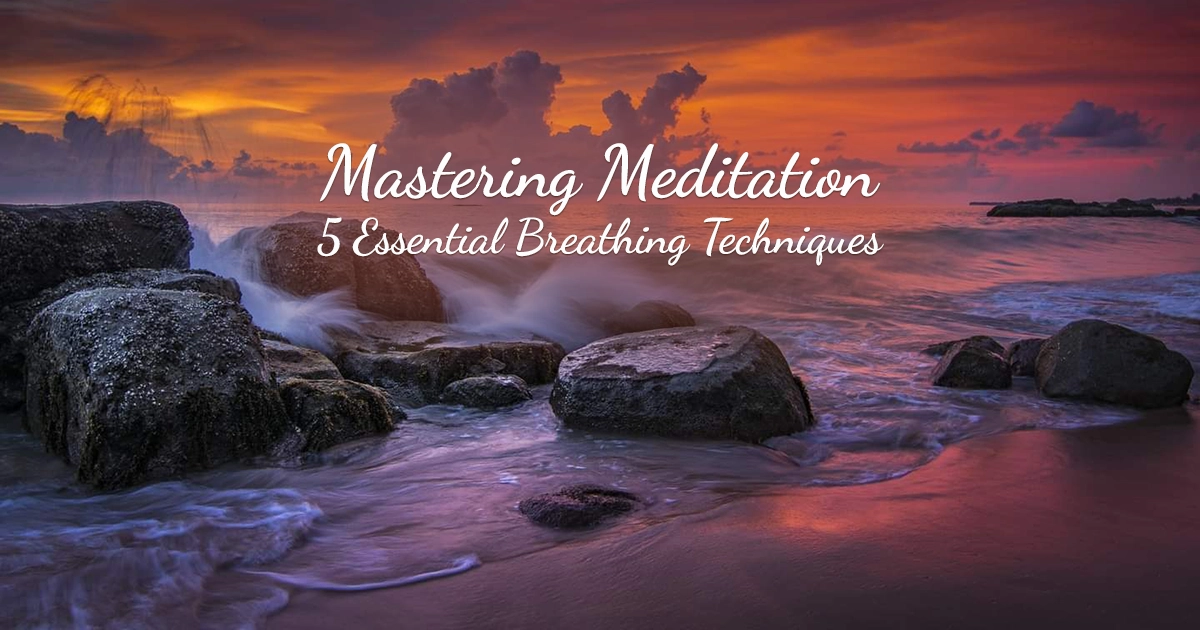Breathing Techniques play a crucial role in the practice of meditation, acting as a bridge between your conscious and subconscious mind. Meditation, an ancient art, can significantly improve your mental, emotional, and physical well-being. Regular practice extends beyond relaxation, helping to reduce stress, enhance creativity, boost empathy, and improve overall mental health. This article will guide you through the basic principles of meditation and specifically focus on five essential breathing techniques. Master these techniques to deepen your meditation practice and unlock its transformative potential.
The Basic Principles of Meditation
Meditation is a practice rooted in silence and stillness. It invites us to step away from the chaos of our daily lives and enter a state of deep peace and relaxation. Yet, it’s not about escaping reality, but rather about experiencing it more fully. By quieting our minds, we can better hear the subtle whispers of our intuition and gain insight into our true nature. The first principle of meditation is mindfulness, the ability to be fully present and engaged with what we are doing, without being distracted by irrelevant thoughts or feelings.
The second principle is non-judgment. It encourages us to accept our thoughts and feelings as they are, without labeling them as good or bad. This acceptance helps us to cultivate a compassionate attitude towards ourselves, fostering self-love and acceptance. Thirdly, meditation requires discipline. While it may seem effortless, it requires consistent practice to reap its benefits fully. A regular routine can help to create this discipline, assisting us in establishing a healthy habit that can carry us through even the most challenging times.
Lastly, breathing lies at the heart of meditation. Controlled breathing not only helps to relax the body but also allows us to delve deeper into our consciousness. By focusing on the breath, we can create a bridge between the physical world and our inner selves, facilitating a deeper connection with our spiritual essence.
5 Essential Breathing Techniques
Breathing techniques form a fundamental part of the meditation experience. They help to relax the body, calm the mind and foster a sense of inner peace.
- The first technique is the “Belly Breathing,” which involves breathing deeply into the diaphragm, filling the lungs to their maximum capacity. This type of breathing encourages full oxygen exchange, promoting a sense of calm and relaxation.
- The second technique is “4-7-8 breathing,” which involves inhaling for a count of 4, holding the breath for a count of 7, and then exhaling for a count of 8. This technique helps to slow down the heart rate and elicit the body’s natural relaxation response.
- The third technique is “Alternate Nostril Breathing.” This technique involves alternately inhaling and exhaling through each nostril, helping to balance both sides of the brain and promote mental clarity.
- The fourth technique is “Box Breathing,” which involves inhaling, holding the breath, exhaling, and then holding the breath again, each for a count of 4. This technique helps to reduce stress and improve concentration.
- Lastly, “Lion’s Breath” involves inhaling deeply through the nose and then exhaling forcefully through the mouth while sticking out the tongue. This technique helps to release tension and promote a sense of energy and vitality.
Mastering Mindfulness: Sustaining Meditation in Daily Life
Integrating meditation into your daily life can be a transformative experience. It begins with setting aside a specific time each day for meditation practice. This regularity helps to establish a routine and makes it easier to maintain the habit. Start with just a few minutes each day, gradually increasing the duration as you become more comfortable with the practice.
Mindfulness can be practiced in any situation, from walking to eating to doing household chores. By focusing on the present moment, we can learn to appreciate the simple pleasures in life, fostering a sense of gratitude and contentment. Remember, meditation is not about achieving a certain state of mind but about cultivating an awareness of our thoughts, feelings, and sensations.
Lastly, patience is key. Don’t rush the process. As with any new skill, it takes time to master. Some days will be easier than others, and that’s okay. The important thing is to keep going, to return to the breath each time you find your mind wandering. With time, you’ll find that meditation becomes less of a practice and more of a way of life.
Mastering meditation is a journey, not a destination. It’s about learning to be present, to listen to your inner voice, and to embrace the fullness of each moment. Through consistent practice and the use of effective breathing techniques, you can cultivate a deep sense of inner peace and mindfulness that extends beyond the meditation cushion and into every aspect of your life.
So breathe with purpose, embrace the quiet, and embark on this transformative journey. Your mind, body, and spirit will thank you.
Adam Bernard is a dedicated meditator and yoga enthusiast, who believes in the power of these practices to promote physical, emotional, and spiritual wellbeing. Professionally a web developer and digital marketer with over 25 years of experience in SEO, SEM, Social Media, eCommerce, and Web Design.


